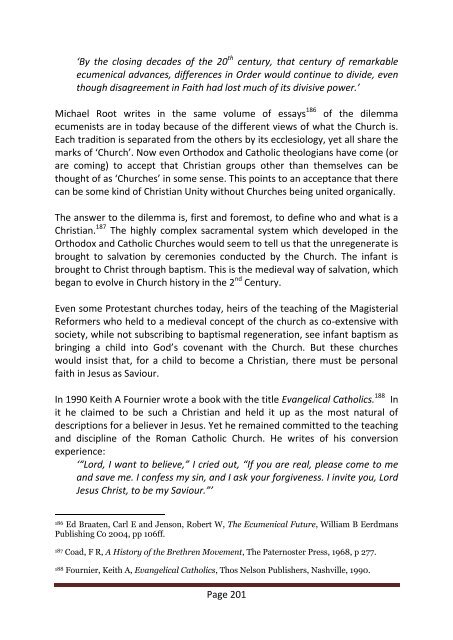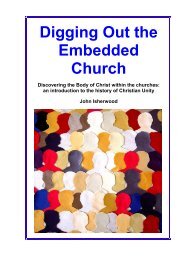Christian Unity (the book) - The Maranatha Community
Christian Unity (the book) - The Maranatha Community
Christian Unity (the book) - The Maranatha Community
Create successful ePaper yourself
Turn your PDF publications into a flip-book with our unique Google optimized e-Paper software.
‘By <strong>the</strong> closing decades of <strong>the</strong> 20 th century, that century of remarkableecumenical advances, differences in Order would continue to divide, eventhough disagreement in Faith had lost much of its divisive power.’Michael Root writes in <strong>the</strong> same volume of essays 186 of <strong>the</strong> dilemmaecumenists are in today because of <strong>the</strong> different views of what <strong>the</strong> Church is.Each tradition is separated from <strong>the</strong> o<strong>the</strong>rs by its ecclesiology, yet all share <strong>the</strong>marks of ‘Church’. Now even Orthodox and Catholic <strong>the</strong>ologians have come (orare coming) to accept that <strong>Christian</strong> groups o<strong>the</strong>r than <strong>the</strong>mselves can bethought of as ‘Churches’ in some sense. This points to an acceptance that <strong>the</strong>recan be some kind of <strong>Christian</strong> <strong>Unity</strong> without Churches being united organically.<strong>The</strong> answer to <strong>the</strong> dilemma is, first and foremost, to define who and what is a<strong>Christian</strong>. 187 <strong>The</strong> highly complex sacramental system which developed in <strong>the</strong>Orthodox and Catholic Churches would seem to tell us that <strong>the</strong> unregenerate isbrought to salvation by ceremonies conducted by <strong>the</strong> Church. <strong>The</strong> infant isbrought to Christ through baptism. This is <strong>the</strong> medieval way of salvation, whichbegan to evolve in Church history in <strong>the</strong> 2 nd Century.Even some Protestant churches today, heirs of <strong>the</strong> teaching of <strong>the</strong> MagisterialReformers who held to a medieval concept of <strong>the</strong> church as co-extensive withsociety, while not subscribing to baptismal regeneration, see infant baptism asbringing a child into God’s covenant with <strong>the</strong> Church. But <strong>the</strong>se churcheswould insist that, for a child to become a <strong>Christian</strong>, <strong>the</strong>re must be personalfaith in Jesus as Saviour.In 1990 Keith A Fournier wrote a <strong>book</strong> with <strong>the</strong> title Evangelical Catholics. 188 Init he claimed to be such a <strong>Christian</strong> and held it up as <strong>the</strong> most natural ofdescriptions for a believer in Jesus. Yet he remained committed to <strong>the</strong> teachingand discipline of <strong>the</strong> Roman Catholic Church. He writes of his conversionexperience:‘“Lord, I want to believe,” I cried out, “If you are real, please come to meand save me. I confess my sin, and I ask your forgiveness. I invite you, LordJesus Christ, to be my Saviour.”’186Ed Braaten, Carl E and Jenson, Robert W, <strong>The</strong> Ecumenical Future, William B EerdmansPublishing Co 2004, pp 106ff.187Coad, F R, A History of <strong>the</strong> Brethren Movement, <strong>The</strong> Paternoster Press, 1968, p 277.188Fournier, Keith A, Evangelical Catholics, Thos Nelson Publishers, Nashville, 1990.Page 201








